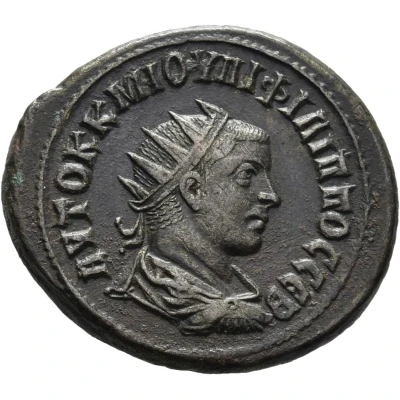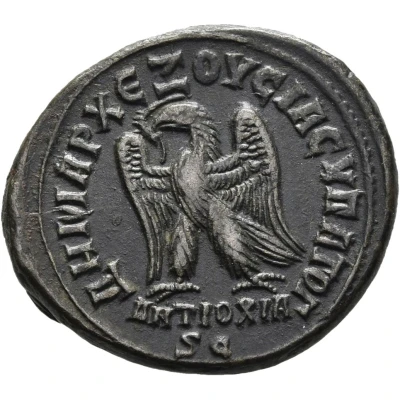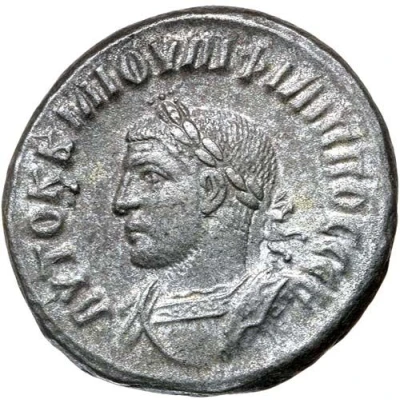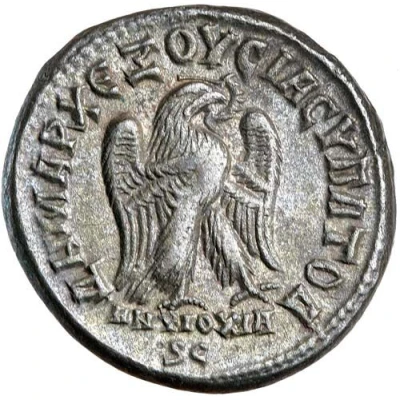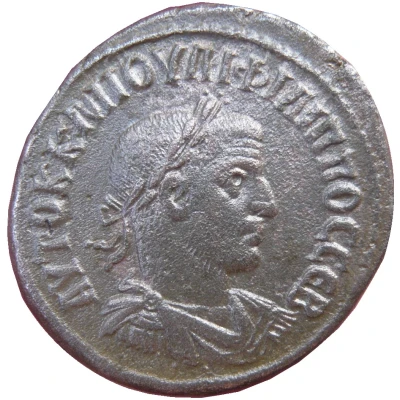
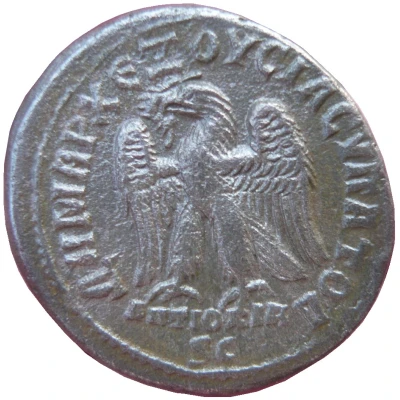

© Darkcid
Tetradrachm - Philippus I ΔΗΜΑΡΧ ΕΞΟΥСΙΑС ΥΠΑ ΤΟ Δ ΑΝΤΙΟΧΙΑ SC; Antioch
| Silver | 12.19 g | 28 mm |
| Issuer | Antioch on the Orontes (Syria Coele) |
|---|---|
| Emperor | Philip I (Marcus Iulius Philippus) (244-249) |
| Type | Standard circulation coin |
| Years | 248-249 |
| Value | Tetradrachm (4) |
| Currency | Drachm |
| Composition | Silver |
| Weight | 12.19 g |
| Diameter | 28 mm |
| Shape | Round (irregular) |
| Technique | Hammered |
| Orientation | Coin alignment ↑↓ |
| Demonetized | Yes |
| Updated | 2024-10-06 |
| Numista | N#74067 |
|---|---|
| Rarity index | 88% |
Reverse
Eagle standing left, spreading wings, holding wreath in beak
Lettering:
ΔΗΜΑΡΧ ΕΞΟΥСΙΑС ΥΠΑ ΤΟ Δ
ΑΝΤΙΟΧΙΑ
SC
Comment
Since the publication of Le Prieur, type 438 has been split into two groups: 438, with a bust where the pterygia on the left are not visible, and 438A, where they are more or less visible.In Antioch, there are a great many mintages dated to the fourth consulship of Philip the Arab, of which we find no trace in Rome. It is extremely regrettable that the little information we have on the Senate of Antioch is much later (4th and 5th centuries), as tetradrachm issues suggest that not only did the Senate of Antioch demonstrate its independence from Rome by minting silver with the titulation "SC / ANTIOXIA", but also that it had its own imperial count under Philip.
Such is the wealth of bust variants for issues circulating in Antioch that some, such as Jean-Marc Doyen, have considered the East to have been, in terms of monetary busts, the laboratory from which the West was to draw inspiration.
Indeed, from Caracalla to Philip, there were numerous variations of busts with attributes, and, contrary to Roman practice, which reserved them for donativa or prestige issues, they were clearly intended for circulation.
It was not until much later, thirty years later, that Rome enriched its repertoire of busts. Was it the persistence of an artistic superiority of the Hellenistic East over the Roman West, four centuries after the conquest of Greece? Was the concern for propaganda exacerbated on the Empire's frontier, but less pronounced in the capital? Was the influence of Semitic emperors preoccupied with their local brand image among the populations from which they came? Oriental concern for form rather than substance? Free and competing engravers in Antioch, slaves and unmotivated in Rome? We don't know, but the fact remains that the evidence is indisputable.
As soon as Philip II was proclaimed august, he continued to use his father's titles on the reverse, but also adopted his title by right. The rule is simple: the father always has a wrinkle on his forehead, the son always a smooth forehead.
Note that sigmas are engraved in C.
The TSP database maintained by Michel Prieur now lists forty-six examples of this type, including six in museums (ANS, two at Yale, British Museum, Berne and Oxford, ex Rauch 40 sale (January 1988), no. 526).
Interesting fact
The Tetradrachm coin of Philippus I (ΔΗΜΑΡΧ ΕΞΟΥΣΙΑΣ ΥΠΑ ΤΟ Δ ΑΝΤΙΟΧΙΑ SC; Antioch) (248-249) from Antioch on the Orontes (Syria Coele) features an image of the goddess Tyche on the reverse side. Tyche was the patron goddess of the city of Antioch, and her image on the coin symbolized the city's prosperity and good fortune.
